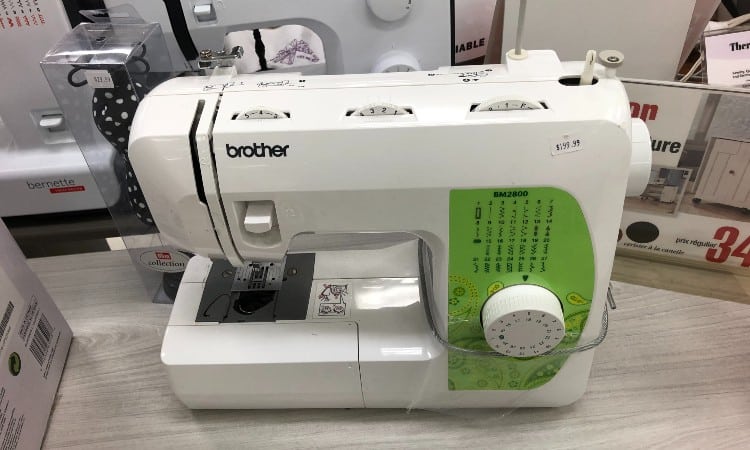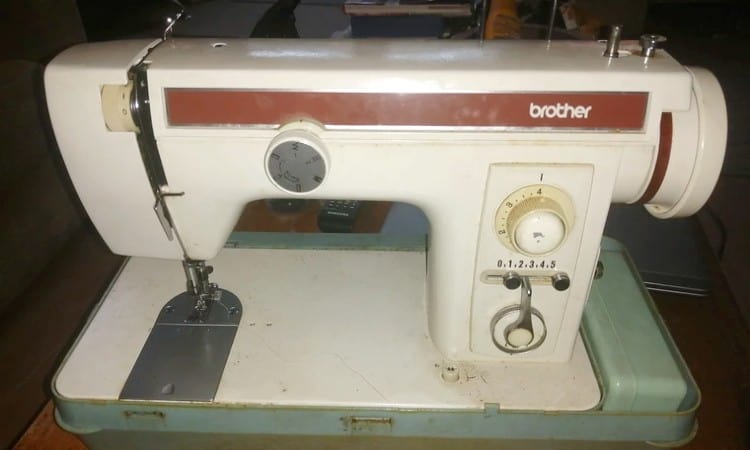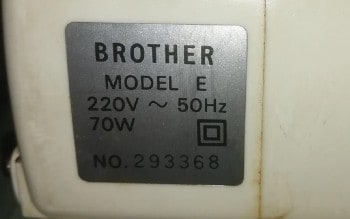If you have a classic avocado green sewing machine from the 1950s, chances are it’s a vintage Brother model! Vintage Brother sewing machine models have an elusive past. The good news is that you don’t have to put on a detective hat to find out all about Brother models, history, and value!
Founded in 1908, Brother Industries remains a successful sewing machine manufacturer today. The company is known for its innovations and even sold the first computerized home sewing machine in the 1970s. Solid metal parts and careful craftsmanship make vintage Brother sewing machines valuable today.
In this article, you will learn all there is to know about the history of Brother sewing machines. You will also find information about the mysterious vintage Brother models. Finally, you will get tips on how to price a vintage Brother model.
History of Brother Sewing Machines
Kanekichi Yasui founded one of Japan’s earliest sewing machine companies in 1908. His company started by making sewing machine parts and providing repairs for industrial machines. At this time, the company went by the name Yasui Sewing Machine Co.
Masayoshi Yasui inherited the company from his father and renamed it Yasui Brother’s Sewing Machine Co. He led the development of the company’s first sewing machine, a chain-stitching model designed to sew straw hats.
The 1930s saw several big breakthroughs for the company. First, Masayoshi’s youngest brother, Jitsuichi, invented a shuttle hook design. This enabled the development of a popular domestic sewing machine.
Second, the brothers launched a successful line of their own industrial sewing machines during the late 1930s. The company also got renamed once again as the Nippon Sewing machine Manufacturing Co. during this decade.
WWII and the Japanese Sewing Machine Industry
The end of WWII and the American presence in Japan had an interesting consequence for the world of sewing machines. As part of the disarmament process, some of Japan’s factories reinvented themselves as domestic goods manufacturers.
Naturally, these domestic goods included sewing machines!
Several prominent sewing machine companies such as Janome got their start during this era. The demand for exported domestic sewing machines in American and Europe offered a great market for Japanese machines. This also led to the popularity of something called “badged” machines.
Many large retailers purchased sewing machines or other appliances made in Japan. The American retailers then rebranded the appliances with the American company brand name.
This dramatically increased the success of many Japanese companies. Unfortunately, it also makes it hard to find out who actually made some sewing machines from this era!
Of course, Brother had a long, successful history before the post-war boom. But the company was able to use the globalization of the sewing machine industry in the early 1950s to its advantage.
Brother sold several badged sewing machines, including the famous Coronados. That said, it also began distributing sewing machines to the States under its own brand name. You can find a good variety of green or blue 50s machines with the iconic cursive “Brother” logo attached in bold chrome letters!
This led to yet another company name change. Brother entered the global market as Brother International Corporation.
Computers and Sewing Machines
In the 1970s, Brother successfully launched the first computerized home sewing machine. This cemented the company’s standing as a leading innovator at a key moment.
Ordinary mechanical sewing machines no longer had enough market to drive sales for such a large company. Because of this, Brother had to continuously adapt to the changing world.
The company diversified into many kinds of office and computer products, a trend they continue today!
Brother Sewing Machines Today
In modern times, home sewing machines are a hobby, not a necessity. The development of synthetic fabrics and the growth of the ready-wear clothing industry made home sewing machines less relevant. Instant access to ready-wear clothing changed the way most people think about clothing!
This led to a decrease in the demand for domestic sewing machines. Very few sewing machine manufacturers managed to stay in business through the 20th century. Singer and Brother are probably the two strongest examples of companies that survived for more than a century.
These popular sewing companies thrived as they entered the 21st century with a new array of computerized products!
Today, Brother Industries makes a huge range of products, from computers to label printers to sewing machines! Sewing products remain one of the largest facets of the company, though.
Popular Older Brother Sewing Machine Models

Source: okie_flats
You can find many popular Brother sewing machine models today, but many of the models made from the 1940s-50s have a sketchier history. Why is it so hard to find info on older Brother models?
Probably for two reasons. The first is a simple language barrier. Brother Industries is an international company today. But most of their records and information from the earlier years only exist in Japanese.
Second, the company seems to have chosen not to make information about some of its vintage models easily accessible. Maybe the company prefers to focus all its energy on promoting its modern models.
That said, it’s also fair to assume that the very successful company does not want to draw a lot of attention to the era of the badged sewing machine in the 1950s. You can understand this choice because many of these machines were sold under another brand name.
All this goes to say that you may have a hard time finding out if Brother made a particular vintage sewing machine.
What Year is My Brother Sewing Machine?
You can find out when your Brother sewing machine was made by contacting the company by email. You may also have luck finding a certified repair technician. As a final option, you can check out sewing forums online.
If you have time and a lot of patience, you can submit a request to Brother via the company’s US website. You will have to go through a lengthy process to do this.
From the support page, you can select the “send an email” option. From there, follow the options, such as selecting that you have a sewing machine query. You will also need to create an account and submit the serial number of your sewing machine.
If this seems too much work, you could choose to reach out to a local repair shop instead. Most certified Brother sewing machine repair technicians know a lot about vintage models. You can try taking your machine in for annual cleaning and ask the technician what they know about your machine.
Alternatively, you could join an online sewing machine forum and ask the group mind what they know about your machine. If you upload a picture of your vintage model, other sewing machine enthusiasts might be able to tell you more about it!
It’s worth noting that you may also find the information you need in the owner’s manual if you’re lucky enough to have it! However, not all vintage Brother manuals will tell you the year your machine was made.
Brother Sewing Machine Model List
Unfortunately, you will not find a comprehensive list of all Brother sewing machine models anywhere online. Brother offers a list of discontinued models here, but this only stretches back to models made during the 2000s. Plus, the website doesn’t even include pictures or product information for many of the models listed!
In this day and age, it’s a mystery how so little accessible information exists about these popular vintage sewing machines! Perhaps someday, a frustrated sewing machine enthusiast will compile a complete list of Brother serial numbers. This would allow you to easily find out what year your Brother sewing machine was made.
For now, though, you may have to resort to posting on an online forum and hoping that someone else knows more about your particular model!
Which Model of Brother Sewing Machine is the Best?
Popular vintage Brother models include the Coronado and the HA-4. Today, you can choose from a wide array of highly acclaimed Brother sewing models. It’s much harder to find information about vintage Brother models.
For example, many badged machines have a model number beginning with the letters “JA” to indicate made in Japan. If you have one of these models, Brother might have made it! Locate the serial number, submit it to Brother, and see what you can learn!
Early Models
Brother does not have any antique sewing machines since their first models were sold in the early 1900s. You would more properly call the early Brother models vintage sewing machines.
The first of these, made in the 1920s and 30s, look like an upside-down letter C made out of spindly cast iron. You will probably not find a lot of these available these days!
These models include the first chain stitch machine Brother manufactured. Brother’s lockstitch domestic machine also looks similar. It sold successfully into the 30s.
1950s
One of the most famous badged machines Brother sold overseas early on was the Coronado. Now, Brother didn’t make all of the bright green models sold as Coronados! Several other manufacturers also made models sold as Coronados, making this extra confusing.
Brother joined the bandwagon in the 50s and used this as one of the company’s footholds to launch a global brand. Coronado models usually have a prominent brand name displayed on the front of the machine. They have a bright or pale green paint job and solid metal parts. They typically offer simple stitching functions such as straight and reverse stitch.
The HA-4, a slightly spiky-looking avocado green model, was also sold during the 1950s and 60s. It has a reliable straight stitch and looks a lot like the Atlas Deluxe models that sold well during this time. Some of these may come with the Brother brand attached as a metal plate.
1970s
In 1979, Brother famously sold the first computerized domestic sewing machine, the Computer Sew 1000. This innovative machine offered the home sewer a wide range of stitches to choose from.
The earliest computerized machines revolutionized the sewing machine industry. The complex embroidery and quilting machine programs you use today got their start out of this first computerized model!
You will probably never find the Computer Sew 1000 for sale on eBay, as it is quite rare today! Brother quickly moved on to inventing a constant stream of computerized machines. These included sewing, embroidery, and quilting machines with advanced computerized technology.
Brother models made in the 1970s contain plastic parts instead of the solid, durable metal parts found in the older vintage models. Everything comes with a cost, and the trade-off for advanced computerized abilities in sewing machines lacks durability.
Modern Machines

Today, Brother remains huge in the sewing world. The company provides a wide array of models ranging from economy options to luxury machines.
Modern Brother machines range a lot in price. You will find beginning models selling for a few hundred dollars on the lower end of the spectrum. At the upper end, advanced quilting and embroidery machines sell for several thousand dollars.
The Brother CS6000i Computerized Sewing and Quilting Machine is one example of a popular modern model. This machine offers 60 stitching options. It has a detachable free arm, a powerful motor, and a handy LCD screen.
This model sells well with both beginning and intermediate sewers. It offers fairly advanced options but also has an automatic threader and runs very smoothly.
The Brother XR9500PRW Project Runway model has a more compact design. It gives aspiring fashion designers an even more advanced 100 stitches to choose from. Because of its simple design, this model also works well for beginning sewers.
Brother manufactures its modern machines at facilities in China and Taiwan. The company sells millions of machines every year!
Where Do I Find the Serial Number on My Brother Sewing Machine?
Most vintage Brother machines have a serial number stamped into a small metal plate. You can often find this plate screwed into the back of the machine. You may also find it beneath the handwheel.
On newer models, you may find the serial number printed onto a sticker.
If you have an official Brother machine that bears the Brother brand name, the serial number uses the first two letters to indicate the manufacturing year. If you have a badged model, though, you will have a harder time matching the serial number to date.
Sometimes both this plate and any badged brand plates may have vanished from the machine. In this case, you will have to resort to trying to match the characteristics of your machine with pictures of other models from a similar era.
For example, what color is your machine? Does it have any chrome decor? What kind of motor does it use?
Remember that once you find the serial number, you can submit a query to Brother for more information if you choose to do so!
Vintage Brother Sewing Machine Manual
Your vintage Brother sewing machine manual provides crucial information such as how to clean, thread, and operate the machine. In some cases, it may tell you what year the machine was made.
You need a manual before you try to clean or set up a vintage machine. This handy mini reference booklet will answer key questions such as whether or not you need to oil the machine!
But what if you bought a vintage Brother model used, and it did not come with the manual? No need to panic! You can find some manuals available through this website.
You can also often find vintage manuals for sale on eBay and Etsy. Some online sellers like SewingPartsOnline also offer a good variety of manuals and vintage parts for Brother models.
Are Vintage Brother Sewing Machines Worth Money Today?
Most vintage Brother sewing machines sell for $100-$300, though you may find a few outliers costing far less or a lot more.
Generally, vintage Brother machines have a reputation as solid, well-crafted machines that will last a long time. That said, they don’t necessarily stand out from the flood of Japanese-made models that rocked the international market in the 1950s and 60s.
Aside from a few rare collector’s items, vintage sewing machines typically have more value for their usability than for their pricing. These solid metal machines don’t break down in five to ten years like many modern models. If you find a vintage Brother model in good repair, it should still work just fine today, even after decades of use!
For this reason, vintage Brother sewing machines rank as good models even if they don’t cost a lot.
The only real downside to purchasing a vintage Brother model is that you will have difficulty finding information about it.
You can typically find a handful of vintage Brother models for sale on eBay or Amazon. You can also find some very nice restored or reconditioned Brother models on Etsy, though these may cost a bit more due to work put into them.
Conclusion
Brother Industries has more than a century of history behind it. The company invented the first computerized home sewing machine. It continues to supply a wide range of innovative sewing machines today.
Vintage Brother models offer durable construction and good craftsmanship, but finding information about older Brother models offers quite a challenge. The company offers a complex query submission process that might provide key information about an older model. You can also buy some Brother sewing machine manuals online to track down information about these vintage models.
Do you have a vintage Brother machine? How did you find out when it was made? Leave a comment below to let us know!


John McGowan
Saturday 23rd of October 2021
Have I believe a vintage Brother.. green case, heavy metal with all the parts & instructions.. instructions say deluxe sewing machine with built-in light & windowmatic stitch selector Inside instructions says “sensational value at $199.50”